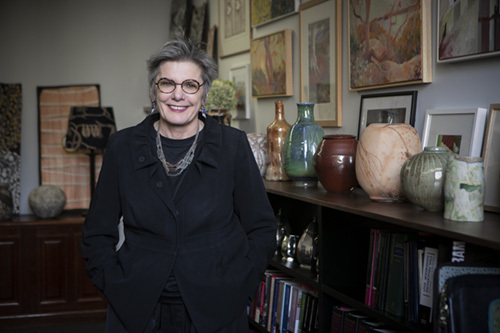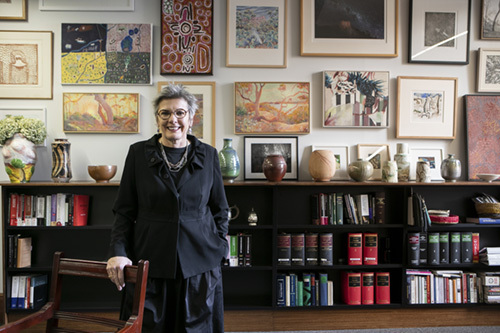- Winter 2023
- Interview with Justice Sarah Pritchard of the Land and Environment Court
Interview with Justice Sarah Pritchard of the Land and Environment Court

Sean O’Brien (SO): Congratulations on your appointment as a judge of the Land and Environment Court of New South Wales. How would you describe the transition from Bar to Bench?
Justice Sarah Pritchard (SP): Thanks Sean. I must say that the transition has been relatively seamless: reading and writing before court, attending court on time robed, remaining poker-faced in court, reading and writing after court, engaging with interesting and more experienced colleagues, and enjoying the support of the most wonderful staff. The main difference is that the phone doesn’t ring as frequently (unless it is my dear mother on the mobile). Despite the occasional suggestion that the life of a judge can be lonely, that has not been my experience so far.
SO: What is ‘judge school’ and could you briefly describe your experience attending ‘judge school’?
SP: Judge school refers to programs conducted by the National Judicial College of Australia which designs and delivers judicial education and training programs for Australian judicial officers across all court hierarchies and jurisdictions. I recently attended the week-long National Judicial Orientation Program in Brisbane conducted by the NJCA. I learnt a great deal and made some new friends. The highlight was the Hon Justice Jayne Jagot telling the newly minted judges in relation to the question ‘What is a good judge’:
• A good judge is fair.
• A good judge listens – or at least listens more than they talk.
• A good judge is civil.
• A good judge makes decisions which are timely.
• A good judge’s decisions are more often right than wrong.
And her Honour’s reassuring counsel to us new judges was: ‘Your basic job is to make decisions – day in and day out – no matter how hard you try, you are going to get some of those decisions wrong.’ And: ‘If I did not know where to start – I hoped for the best and just started writing’.

Indigenous Australian Art Collection
SO: Your judicial chambers are filled with an impressive collection of Indigenous Australian artworks, as your barrister’s chambers were. I understand you have a particular appreciation for Aboriginal artefacts and bark painting. What is it that you most appreciate about these artworks?
SP: I find Aboriginal and Torres Strait Islander artefacts profoundly moving. They are the material manifestation of the pre-European and continuing economic, social and cultural practices of Indigenous people in this country. They are also, in the main, striking sculptural works. I have the present care and custody of several pieces from north- western New South Wales from the nineteenth century. As to bark paintings, the first paintings on bark were made in the early 1900s, with the imagery based on painted body designs and rock art, and with bark a more sympathetic painting surface. Bark, the artist’s canvas, as Wally Caruana has explained, is stripped from Eucalyptus tetrodonta (stringybark) during the wet season, then cured over fire and flattened under weights. The first collections of bark paintings were put together by Walter Baldwin Spencer from 1912 when he visited the buffalo hunting camp of Paddy Cahill at Oenpelli (now Gunbalanya) in western Arnhem Land. Bark paintings carry one of the oldest continuing traditions of art known to humankind and are very beautiful. For further expert explanation, please refer this question to (my friend) Jo Holder of Cross Art Projects.
Civil and common law systems
SO: I understand that you obtained your Doctor of Laws from the Eberhard Karl University of Tubingen in Germany. Based on your experience and knowledge of the civil code system of justice can you compare and contrast it with our own common law system, especially in terms of its legitimacy as an arm of government?
SP: It was an extraordinary opportunity to live and study in Germany and complete my masters and subsequently doctorate in law there. At the end of the day, despite the different origins of the codified and inquisitorial German (Roman) civil law system and our common law legal system, I have arrived at the conclusion (largely thanks to Professor Dietrich Rothoeft, and Professors Zweigert and Kötz) that pretty much nothing falls between the cracks in either system in terms of the determination of people’s legal rights, duties and liabilities according to law. In Germany, the independence of the judiciary is constitutionally guaranteed; in civil matters, the system is adversarial. It is often said that the main difference between the two systems is that in common law countries, case law is of primary importance, whereas in civil law systems, codified statutes predominate. However, in Germany, in practice, the lower courts are aware of and deferential to the decisions of higher courts, such as State appeal courts and the Bundesgerichtshof and the Bundesverfassungsgericht. And in Australia, we are increasingly subject to codification. In Class 4 proceedings (environmental planning and protection, development contract and strata renewal plan civil enforcement), the Land and Environment Court has jurisdiction to hear and dispose of proceedings under 42 statutes, as well as to hear and dispose of proceedings to enforce any right, obligation, or duty conferred by a planning or environmental law etc, of which there are 28. In Class 5 proceedings (environmental planning and protection summary enforcement), the court has jurisdiction to hear and dispose of, in a summary manner, proceedings under 25 pieces of legislation. Pace the Federal Court.
The only further comment I would make is that there may be something to be said for the system of judicial appointment in Germany with career judges commencing their appointment much earlier, after graduation, but for life, and assignments to courts changing through the course of the judge’s career.
Timor-Leste
SO: During your years of practice at the Bar you developed close ties with the East Timorese community and government. Can you elaborate on the rewards and challenges of that work? Also, do you have any observations that might assist barristers interested in doing pro bono work?
SP: The work in and in relation to Timor- Leste was amongst, if not the most significant of my professional life. The work goes back to the early 1990s when I was working as an adviser to Indigenous Australian organisations at the United Nations in Geneva and was introduced to the East Timorese delegation. East Timor, then, had no recognised capacity to address the UN Commission on Human Rights. Some aspects of the work in the 1990s are perhaps sensitive, but as noted in my swearing-in speech, on 30 August 1999 the Peoples Consultation or independence referendum was held in East Timor. The voters’ rejection of the proposed special autonomy resulted in a humanitarian crisis. A group of East Timorese women, including Natalina Ramos Horta, the mother of the nnow (not for the first time) president, held a vigil outside the UN Information Centre in York Street. In the early hours of 15 September 1999, we were together on York Street listening to the proceedings of the UN Security Council when we heard, in real time, that the Security Council had ratified the resolution that the formation of a multi-national force, INTERFET, was to be immediately sent to East Timor to restore order and security and end the humanitarian crisis. On 23 September 1999, in Geneva, I sat between Bishop Bello and Jose Ramos Horta, two Nobel Peace Prize laureates, and addressed the special session of the UN Commission on Human Rights convened to address the human rights situation in East Timor. For only the fourth time in its history, the Commission had come together to respond to an emergency situation in the field of human rights. In December 1999, with a small group, I accompanied the now president who had left his country at the end of 1975 on his return to Timor-Leste. It was deeply affecting to tour Timor-Leste at this time. In Dili, I stayed with a number of East Timorese women, including my dear friend, her Excellency the Ambassador to Australia, Ines Almeida, who had also left East Timor as a refugee in 1975. I have since visited Timor-Leste many times, as a lecturer and trainer, including training the first group of East Timorese diplomats in 2000 in relation to international law and practice.
As to pro bono work, for me it was always heartening and an enormousprivilege, in relation to Timor-Leste and otherwise, to meet and learn from people with whom I would otherwise not have come into contact. Barristers’ lives in Phillip Street and environs can, at times, be somewhat cloistered. At the same time, I am conscious of the importance of maintaining a cash flow. Pro bono work is a very personal matter. But anyone who is interested should reach out to relevant organisations. It can be hugely rewarding.
Native Title and Aboriginal land rights
SO: Your work as a barrister also involved acting in Aboriginal land rights cases and for native title claimants. What did you find to be the most rewarding and challenging aspects of that work? Do you have any observations that might assist barristers interested in doing similar work?
SP: It is difficult to say what was the most challenging aspect of my practice in relation to native title and Aboriginal land rights. I found it at all times endlessly fascinating and enjoyed the collegiality and wisdom of clients and those instructing me. And my memory of some of the views, such as those of the Torres Strait sea country, from the air, over two weeks during the initial hearing of the Torres Strait native title sea claim, will never be erased. It will not be everyone’s cup of tea, but if you are interested, reach out.
Judicial role models
SO: Do you have any judicial role models or mentors that you would like to mention? If so, what are the aspects of their judicial persona or work that inspire or guide you in performing your judicial role?
SP: Awkward. This is probably your most difficult question, Sean. Michael McHugh AC KC was and remains the most significant influence on my career, at all times an unfailingly generous and encouraging mentor. Having been his tipstaff at the Court of Appeal in 1987, it was the honour of a lifetime subsequently to be asked to return from Germany in early 1989 to take up the role as one of his first two associates in Canberra. Keith Mason AC KC, the most consistently courteous and thoughtful judge before whom I sadly appeared only infrequently. The chief judge, the Hon Justice Brian Preston, with whom I read and who, since his appointment as chief judge in 2005, has forged an international reputation for the Land and Environment Court and made a singular contribution to the jurisprudence in Australia and internationally in relation to the concept of ecologically sustainable development. The Hon Justice Jayne Jagot, for her humility, warmth and kindness, wit and extraordinary intellect.

The Land and Environment Court, and climate change
SO: Can you elaborate on the work of the Land and Environment Court? What has been the contribution of the court to the jurisprudence in relation to climate change?
SP: It is an honour to have been appointed to the Land and Environment Court, the first specialist superior court of its kind in the world. The court was established in 1979, providing for the first time in one location for merit appeals, important work carried out for the most part by the court’s Commissioners, and for the declaration and enforcement of environmental law. Its jurisdiction extends to, inter alia, environmental planning and protection appeals (Class 1), land tenure, valuation, rating and compensation matters, including appeals under the Aboriginal Land Rights Act 1983 (Class 3), environmental planning and protection, development contract and strata renewal plan civil enforcement – some of, if not the most important judicial review matters in New South Wales (Class 4), and environmental planning and protection summary enforcement – in other words, prosecutions for environmental offences (Class 5).
There has been consideration of climate change in both Class 4 and Class 1 proceedings in the court. Four early judicial review cases are Gray v Minister for Planning [2006] NSWLEC 720, (2006) 152 LGERA 258 (Pain J); Drake-Brockman v Minister for Planning [2007] NSWLEC 490, (2007) 158 LGERA 349 (Jagot J); Walker v Minister for Planning [2007] NSWLEC 741, (2007) 157 LGERA 124 (Biscoe J); and Aldous v Greater Taree Council [2009] NSWLEC 17 (Biscoe J). In Aldous, Biscoe J reviewed ESD principles and the Australian and overseas cases. In Gray, Pain J held that downstream burning of coal from a proposed coal mine was a relevant matter for consideration under Part 3A of the EPA Act (since repealed) in the environmental assessment of the mine, and in the Director-General’s decision as to whether the environmental assessment adequately addressed the Director-General’s requirements.
In Bushfire Survivors for Climate Action Incorporated v Environment Protection Authority [2021] NSWLEC 92, the chief judge, Preston J, ordered the NSW EPA to perform the statutory duty imposed by s 9(1)(a) of the Protection of the Environment Administration Act 1991 to develop environmental quality objectives, guidelines and policies to ensure the protection of the environment in NSW from climate change.
In Class 1 proceedings, in Gloucester Resources Ltd v Minister for Planning (2019) 234 LGERA 257; [2019] NSWLEC, the chief judge, in refusing the appeal, held that the proponent had failed to prove that market substitution or carbon leakage would actually occur (at [536]); that there was no certainty that there will be market substitution or carbon leakage by new coal mines being approved in other countries in order to supply the coal that would have been produced by the proposed project in Australia (at [538]); that the ability of a new coal mine in another country to substitute any coal lost by refusal of the proposed project in Australia will depend on the market (at [541]); and that there was a logical flaw in the market substitution argument (at [545]). The decision has garnered significant national, as well as international, attention.
Extracurially, the chief judge has written extensively on the expanding law on climate change.1 BN
ENDNOTES
1 See, for example: ‘Climate conscious lawyering: Five ways that lawyers can implement a climate conscious approach in their daily legal practice’ (2021) 95 Australian Law Journal 51; ‘The influence of the Paris Agreement on climate litigation: Legal obligations and norms (Part I)’ (2021) 33(1) Journal of Environmental Law 1; ‘The influence of the Paris Agreement on climate litigation: Causation, corporate governance and catalyst (Part II)’ (2021) 33(2) Journal of Environmental Law 227; ‘The evolving role of environmental rights in climate change litigation’ (2018) 2 Chinese Journal of Environmental Law 131; ‘Climate justice and the role of an international environmental court’ in M Baker-Jones (ed), Climate Change Adaptation, Planning and the Law (2015, DLA Piper, Brisbane); ‘Adapting to the impacts of climate change: The limits and opportunities of law’ (2013) 30 Environmental and Planning Law Journal 375; ‘The influence of climate change litigation on governments and the private sector’(2011) 2(4) Climate Law 485; ‘Climate change litigation (Part 1)’ (2011) 5(1) Carbon and Climate Law Review 3; ‘Climate change litigation (Part 2)’ (2011) 5(2) Carbon and Climate Law Review 244; ‘The role of courts in relation to adaptation to climate change’, in Tim Bonyhady, Jan McDonald and Andrew Macintosh (eds), Adapting to Climate Change: Australian Law and Policy (Federation Press, 2010); ‘Climate change litigation’ (2009) 9(2) The Judicial Review 205, republished in (2009) 26 Environmental and Planning Law Journal 169.
